The Ultimate Beginner’s Guide to APC – PART 1
STEP 1: PAINT
In this first series’ post to The Ultimate Beginner’s Guide to APC, we’ll cover everything you might expect from using APC Clay, Chalk, Mineral Base paint for the first time. We’ll cover how to prep your pieces, what brushes to use, and some basic troubleshooting should you experience some difficulties!
There are many advantages to painting with American Paint Company’s Clay paint. For starters, it’s 100% eco-friendly, which means if you choose to paint indoors, you won’t have to worry about harsh fumes in your home. Secondly, it’s thick and covers well, adhering to many different surfaces such as wood, brick, even glass. The thickness of the paint will save hours of sanding, priming and prep work in general, which let’s face it, is our least favorite part of painting! Just grab a brush and you’re basically ready to go! Also, unlike latex or acrylic based paints, APC’s Clay, Chalk, Mineral Base paint dries fast! No wasted time watching your piece dry! And did we mention that it distresses easily? Achieve the vintage look easily without the stresses of chipping or peeling paint. Using APC products will save you time on your project yet maintain the flexibility to personalize your piece to your liking! And with our vast product inventory we’re sure you’ll find everything to bring your decor vision to life.
What project should I start on first?

If you’re using APC products for the first time, we recommend a starter project like a small decor piece, an end table, or a small accent piece. Starting on bigger projects such as your kitchen cabinets or dining room table is not recommended unless you are an experienced painter. Although painting with Clay paint is forgiving and easier than painting with latex or acrylic-based paints, it is different than what most people are used to, so you might want to practice first before repainting that prized piece of furniture. APC paint will adhere to any surface such as glass, wood, plastic, brick or more. However, it will adhere differently to each surface, so a little practice goes a long way to getting the best possible results. Painting glass and plastic can be tricky, so we recommend you start of on a wooden piece of furniture or decor.
Should I clean my furniture before painting?

It is important to clean your piece properly before painting. A lot of old furniture has dirt, grease or grime that has built up over the years and it’s best to paint on a clean surface. We recommend using APC’s 100% Organic Surface Prep. In most cases, you do not need to sand or prime your furniture before painting (thank heavens!).
In rare cases where a piece of furniture has been previously sealed with wax or oils, you may want to take extra precautions. Paint doesn’t adhere properly to wax, and oil can quickly seep through clay paint because it is breathable and porous. In these cases, we recommend sealing the furniture or the stains first. You can do this with a product such as shellac, or Top Coat which is the all-natural alternative from American Paint Company.
Having to seal prior to painting is pretty rare, but there are a few tricks you can try before painting to help you discover whether or not you’ll have to. First try dropping a couple of drops of water on your piece. If it beads up the same way water beads up on a freshly waxed car and/or leaves a water stain, you’re dealing with a wax/oiled finish. You can also try a swipe of paint on your piece. Let it dry and if it flakes off, you’ll have to seal with Top Coat to establish that barrier.
![]()
What colors should I use?
You can use several colors if you want. Using a white or neutral color as a base or primer color will really enhance the vibrancy of whatever other color you choose. Colors such as Fireworks Red, A-maize-ing, and Beach Glass will really pop with a neutral primer. APC Clay/Chalk/Mineral Base paint is highly pigmented so rest assured that whatever color you decide to go with, you’ll achieve stunning results. Here’s a link to a complete guide for choosing the right colors.
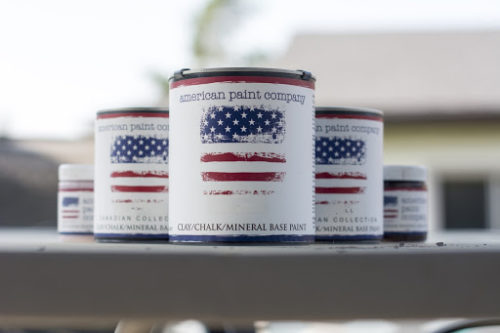
How much paint do I need?
A little goes a long way – especially when you mix with water (mixing with water?! What is this sorcery? Read on, we cover this below). But note, the amount of paint needed depends on what color you are using and what color you are painting over. It also depends on the type of furniture.
For example, if you were to repaint your black wall using white paint, it would take several coats to cover it completely, right? First, you’d likely want to add a neutral color such as a grey, and then several layers of white.
This same logic applies to using Clay, Chalk and Mineral Paint. If your furniture is a dark paint color, it’s using a dark paint base. A white or light color uses a clear paint base. You’ll want to plan to use more paint if you’re trying to cover a dark paint base using a clear base color.
Next, the amount of paint you use will depend on what type of furniture you are painting. For example:
- Raw wood may absorb more of the paint then a previously painted piece.
- A slippery surface such as Ikea furniture might not adhere with the first coat, causing you to continue to add paint, creating a layered cake-like piece.
- Kitchen cupboards might have some sort of oil based clear sealer on them, causing the porse clay paint to not cover as well as on other types of surfaces.
So while we can take a guess at how far the paint will go for you, it also depends on the type of furniture, surface material, and previous sealers used.
But for the most part and in most cases, clay paint goes A LONG WAY. Not only that, you can dilute the paint with water WITHOUT changing the color or pigments. This allows you to thin down the paint to a consistency you enjoy. It also allows the paint to go further and gives you the ability to complete more projects with the same can of paint.
American Paint Company Paint Sizes:
Here’s a breakdown of the 3 sizes that APC carries. Below you’ll find approx. coverage for each size, and projects you can complete with that amount of paint:

American Paint Company products are available in 3 sizes including Pots, Pints and Quarts.
Pots: 4oz / 10 sq.ft / Ideas: Bar stool, frames, candle sticks, etc.
Pints: 16oz / 35 sq. ft / Ideas: Office desks, dressers, bookshelves, etc.
Quarts: 32oz / 75 sq.ft / Ideas: Dining sets, bedroom set, living room set (coffee table & end tables).
The best value will always be to buy in bulk. In other words, purchasing a quart will be the best bang for your buck. We recommend always buying a quart size in the whites and neutral colors. If you’re not sure about using a full quart of your bold colors, you can go with the pints, or even pots to try it out for the first time.
How long will the paint last?
The recommended shelf life after opening the can is about 1 year. After opening the can, the air will get in and begin to dry out the clay over time. We’ve found that by adding a little water to a dried out can of clay paint gives new life to the paint, and allows you to start painting again! I bet you can’t say the same thing about latex and acrylic paints… When adding water to your paint, distilled water is recommended but not necessary! Tap water will get the job done as well.
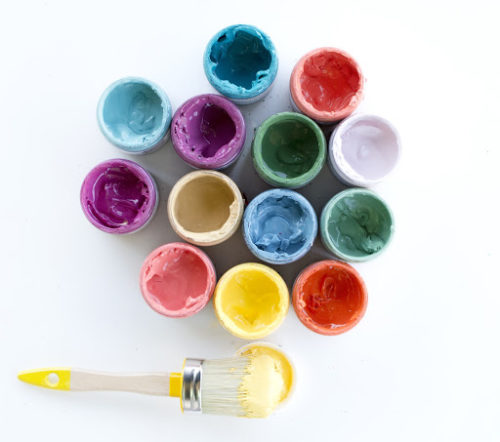
Most latex paints don’t have a long shelf life and the pigments seem to sink to the bottom of the can, and the chemical layer settles on top. But our all-natural pigments stay consistently mixed with the clay even over long periods of time. After a few years, you’ll notice the clay has become hard and dry. Simply add some water, mix it up and start painting again!
Do I need to use a special brush?

A lot of people ask if they need a special paint brush. Or will a regular paint brush from the hardware store work? The short answer is, yes, we do recommend a special brush that has been designed for thicker clay paints.
One thing to note is that the size, style and type of brush will usually impact the results of your project in a big way.
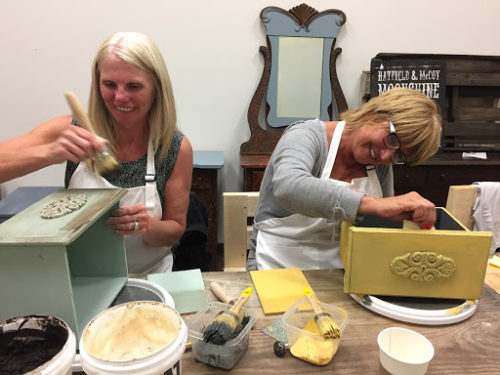
Using a chip brush usually makes it difficult to get good coverage. These thin bristle brushes don’t hold much paint, and were designed for more of a thinned out latex based paint.
Oval brushes that are natural bristle tend to hold more paint, allowing you longer and more even brush strokes. They’re your best bet for the best coverage.
You’ll also want to consider what size of a paint brush to use. Generally speaking, you’ll want a bigger sized brush for bigger furniture projects; and on smaller projects such as decor pieces, you’ll be able to get away with using a smaller brush.
Most APC retailers use the Vintiquities brand of paint brushes. Vintiquities brushes are natural bristle brushes, oval in shape, and have a comfortable handle grip.
We do not recommend using rollers. Clay paint is quite thick and rollers will leave a speckled and uneven layer.
What other tips or basic instructions should I know?
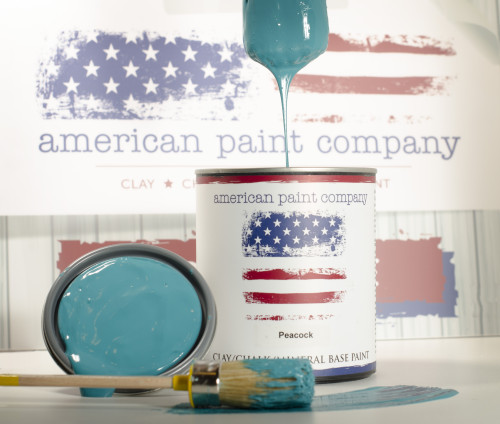
Paint Tip #1: If you’re used to traditional latex and acrylic based paints, you’ll notice APC’s clay based paint is quite thick. Don’t worry! There is nothing wrong with your can of paint, this is normal. In fact, APC customers love the thick nature of the paint. Thicker paint is easier to distress and results in better coverage. If the clay based paint is still too thick for your liking, add a little water to your paint until you reach the consistency you’re happy with.
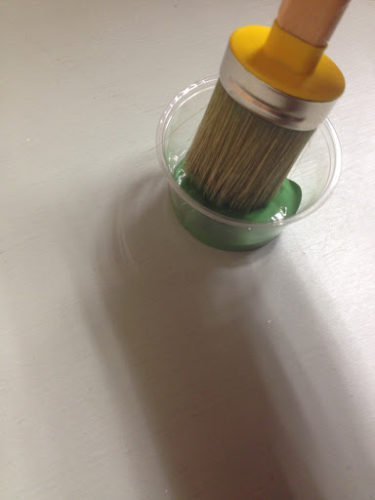
Paint Tip #2: Because the paint is all-natural, it can be contaminated if you dip a used paint brush directly into the can. Be warned, contaminated paint smells like rotten eggs! Even though you can still use the paint, we don’t recommend it, so try to avoid dipping your brush directly into the can. Instead, it’s recommended that you pour enough paint into a separate dish to complete your project.
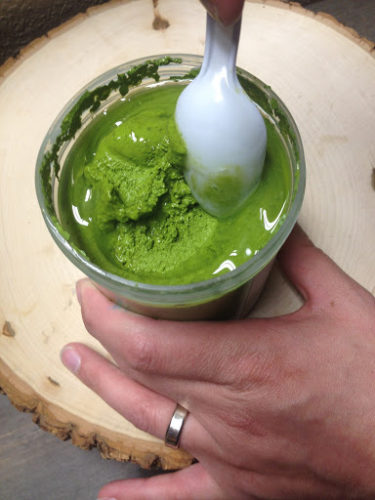
Paint Tip #3: Do not let the paint or liquid sealers freeze. Ensure you store your paints where the temperatures will NOT drop below freezing (like your garage or car). Once your paint freezes it will crystallize, making it very difficult, if not impossible to use in the future. It’s also important not to let your paint get too hot. This can change the viscosity of the paint, making it too thin to completely cover your piece of furniture. Make sure to store them inside at normal room temperature.
How do I apply the paint to the furniture?
You can assume applying the paint is the easiest step, in which case, you’d be correct. When applying the paint to your furniture, dip your brush into the paint and then apply to your furniture. Rocket science, right? Open the can, pour it into a dish, dip your brush and start applying in long strokes. Remember to keep the first coat thin if you don’t want brush marks to show through. Let your piece dry for 30 minutes before adding another color so that it doesn’t blend – or before applying sealers.
In the next post of this series, we’ll cover how to distress your piece!

We Love to Hear From You